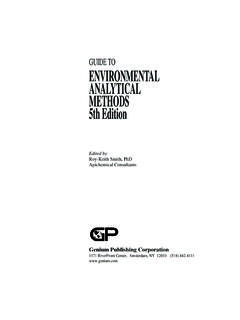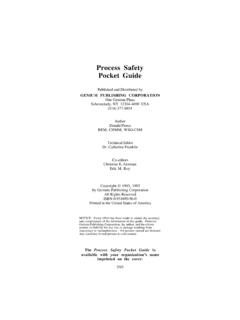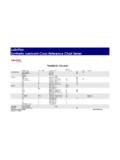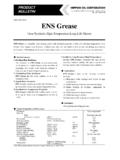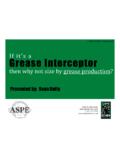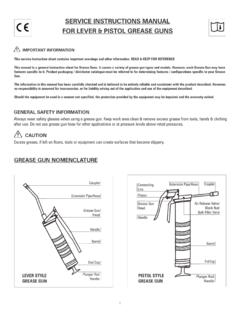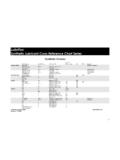Transcription of Lecture 15 Oil, Grease, Surfactants, and Hydrocarbons
1 Genium Publishing Corporation293 Lecture 15 Oil, grease , Surfactants, and HydrocarbonsLectures 4 and 5 discussed the analysis of individual organic compounds by gaschromatography and gas chromatography-mass spectrometry. Use of thesemethods requires a specific defined target analyte, such as 1, instrument is calibrated for the specific target analyte, and part of theanalysis is the determination that the target compound is present and not beingconfused with another closely related compound such as are literally millions of possible organic compounds that canpotentially be present in wastewater.
2 And it is impossible to even consider tryingto analyze the sample for every compound. At the same time, the mass of thesenon-target organic compounds can contribute substantially to the pollutionpotential of the are test methods available that can directly or indirectly estimate theorganic loading of an effluent. Biochemical oxygen demand (BOD) discussed inLecture 6, is an indirect measure of the organic material present, as is totalorganic carbon, TOC.
3 BOD is oriented toward measuring how much of the organicmaterial is degradable, but it is effected by contributions from degradableinorganic substances. TOC is a more complete measure. However, it requires thatthe material be soluble in the water sample, due to the mechanics of the sampleintroduction. Organic substances that are not soluble in water are inefficientlymeasured by either TOC or insoluble organic materials are of concern. Aside from any specific toxiceffect due to ingestion of a particular component of the mixture, insoluble organicmaterial can present environmental problems.
4 Most persons are familiar with thepictures of the results of oil spills on the fauna and flora in the immediate area,the oiled birds and dead sea otters, the coated rocks. Insoluble organic materialsin effluent create the same problems only on a smaller scale because of thesmaller quantities (mg/L to g/L). Even on this smaller scale they can causedeath, coating the gill surfaces of fish, amphibians, insects, and other creaturesliving in water, preventing the transport of oxygen from the water into the animaland interrupting total amount of insoluble organic material in an effluent can beanalyzed.
5 A simple isolation of the insoluble organic material from the waterportion of the sample and then determination of the weight of the isolatedmaterial is a valid direct measurement. The exact details of the isolation processdepend on the composition of the organic material. In broad terms, insolubleorganic material is composed of oils and greases, surfactants, petroleumhydrocarbons, and a variety of miscellaneous substances from chemicalmanufacturing and other industrial term oil is meant to indicate a water insoluble organic material that is aliquid at room temperature.
6 The term grease means a water insoluble organicLectures on Wastewater Analysis and Interpretation294 Genium Publishing Corporationmaterial that is a solid or semi-solid at room temperature. There are otherconnotations that many people associate with these terms, such as oils meaning alubrication fluid, while a grease is a lubrication solid. However, the lubricationqualifier more or less limits one s thinking to a petroleum-based product. Whilepetroleum-based components can be a significant contributor to particular oil & grease problems, there are many effluents that exhibit oil & grease without anytrace of petroleum.
7 Under this broad definition of oil & grease , many substancesfall into the the food industry, oil & grease in the effluent is largely composed ofedible fats of plant and animal origin. The sub-category term edible fats coversa lot of ground, although the common link within the group is the presence of afatty acid. A fatty acid is characterized as a long-chain aliphatic hydrocarbonwith a carboxylate group on one end. Stearic acid, the common name foroctadecanoic acid, is a widely distributed fatty acid of 18 carbon acids of plant and animal origin contain an even number of carbonatoms, as the biosynthesis is an acetic acid-based process.
8 The naturally-occurring fatty acids all have common names, presented in Table 15-1, frequentlyreflecting the original source of the material. Palmitic acid was derived frompalm trees. The term saturated indicates that there are no double bonds in thecarbon chain. Unsaturated means that there are double bonds in the carbon chain,and polyunsaturated indicates there are more than 15-1. Some common names for fatty acidsCommon nameof acidIUPAC nameNumber of carbonsand unsaturationn/aButyric4:0 ValericPentanoic5:0 CaproicHexanoic6:0 EnanthicHeptanoic7:0 CaprylicOctanoic8:0 PelargonicNonanoic9:0 Caproleic9-Decenoic10:1 LauricDodecanoic12:0 TridecylicTridecanoic13:0 MyristicTetradecanoic14:0 PentadecylicPentadecanoic15:0 PalmiticHexadecanoic16:0 Palmitoleiccis-9-Hexadecenoic16:1 Lecture 15.
9 Oil, grease , Surfactants, and HydrocarbonsGenium Publishing Corporation295 Table 15-1. Some common names for fatty acids, continuedCommon nameof acidIUPAC nameNumber of carbonsand unsaturationMargaricHeptadecanoic17:0 StearicOctadecanoic18:0 Oleiccis-9-Octadecenoic18:1 Linoleiccis-9,12-Octadecadienoic18:2 Eleostericcis-9,11,13-Octadecatrienoic18 :3 Linoleniccis-9,12,15-Octadecatrienoic18: 3 ArachidicEicosanoic20:0 Gadoleiccis-9-Eicosenoic20:1 Arachidoniccis-5,8,11,14-Eicosatetraenoi c20:4 BehenicDocosanoic22:0 Eruciccis-13-Docosenoic22:1 LignocericTetracosanoic24.
10 0 Nervoniccis-15-Tetracosenoic24:1 CeroticHexacosanoic26:0 MontanicOctacosanoic28:0 Besides the straight-chain aliphatic fatty acids that are presented in Table15 1, there are fatty acids that are branched-chain, the most frequent branchbeing a methyl group, CH3-. There are also fatty acids with other functionalgroups attached to the hydrocarbon chain. The most common of these is ricinoleicacid, 12-hydroxy-9-octadecenoic acid, which has an alcohol group attached at the12 position.


